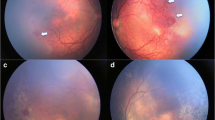Abstract
Retinopathy of prematurity (ROP) occurs due to abnormal proliferation of retinal vessels. The most important risk factors which predispose to development of ROP include oxygen therapy, anemia needing blood transfusion, sepsis and apnea. Very low birth weight neonates, those born at ≤32 week of gestation and other preterm neonates with risk factors must be screened for ROP. As a general rule first screening should be done at 1 month of postnatal age. If screening detects ROP not needing treatment follow up should be planned according to location and stage of ROP. Better visual outcomes are observed with earlier treatment at lower threshold. Peripheral retinal ablation with diode laser under adequate analgesia and sedation is the preferred method for treatment of severe ROP. Guidelines regarding the procedure of dilatation, ophthalmic examination and treatment (if required) have been provided in the protocol. Close co-operation between the ophthalmologist and neonatologist is essential for successful management of ROP.


Similar content being viewed by others
References
Flynn JT. The premature retina: a model for the in vivo study of molecular genetics? Eye. 1992;6:161–5.
Kushner BJ, Essner D, Cohen IJ, Flynn JT. Retrolental fibroplasia II. Pathologic correlation. Arch Ophthalmol. 1977;95:29–38.
Chan-Ling T, Tout S, Hollander H, Stone J. Vascular changes and their mechanisms in the feline model of retinopathy of prematurity. Invest Ophthalmol Vis Sci. 1992;33:2128–47.
Chan-Ling T, Gock B, Stone J. The effect of oxygen on vasoformative cell division. Evidence that ‘physiological hypoxia’ is the stimulus for normal retinal vasculogenesis. Invest Ophthalmol Vis Sci. 1995;36:1201–14.
Chaudhari S, Patwardhan V, Vaidya U, Kadam S, Kamat A. Retinopathy of prematurity in a tertiary care center—incidence, risk factors and outcome. Indian Pediatr. 2009;46:219–24.
Charan R, Dogra MR, Gupta A, Narang A. The incidence of retinopathy of prematurity in a neonatal care unit. Indian J Ophthalmol. 1995;43:123–6.
Gupta VP, Dhaliwal U, Sharma R, Gupta P, Rohatgi J. Retinopathy of prematurity—risk factors. Indian J Pediatr. 2004;71:887–92.
Maheshwari R, Kumar H, Paul VK, Singh M, Deorari AK, Tiwari HK. Incidence and risk factors of retinopathy of prematurity in a tertiary care newborn unit in New Delhi. Natl Med J India. 1996;9:211–4.
Aggarwal R, Deorari AK, Azad RV, et al. Changing profile of retinopathy of prematurity. J Trop Pediatr. 2002;48:239–42.
Dutta S, Narang S, Narang A, Dogra M, Gupta A. Risk factors of threshold retinopathy of prematurity. Indian Pediatr. 2004;41:665–71.
Rekha S, Battu RR. Retinopathy of prematurity: incidence and risk factors. Indian Pediatr. 1996;33:999–1003.
Gopal L, Sharma T, Ramachandran S, Shanmugasundaram R, Asha V. Retinopathy of prematurity: a study. Indian J Ophthalmol. 1995;43:59–61.
Varughese S, Jain S, Gupta N, Singh S, Tyagi V, Puliyel JM. Magnitude of the problem of retinopathy of prematurity. experience in a large maternity unit with a medium size level-3 nursery. Indian J Ophthalmol. 2001;49:187–8.
Sharma P. DM dissertation: Risk factors for severe retinopathy of prematurity in preterm low birth weight neonates Department of Pediatrics. New Delhi: All India Institute of Medical Sciences 2009 (Submitted for publication to Indian Journal of Pediatrics).
Saunders RA, Donahue ML, Christmann LM, et al. Racial variation in retinopathy of prematurity. The cryotherapy for retinopathy of prematurity cooperative group. Arch Ophthalmol. 1997;115:604–8.
Hellstrom A, Hard AL, Engstrom E, et al. Early weight gain predicts retinopathy in preterm infants: new, simple, efficient approach to screening. Pediatrics. 2009;123:e638–45.
Hellstrom A, Ley D, Hansen-Pupp I, et al. New insights into the development of retinopathy of prematurity—importance of early weight gain. Acta Paediatr 2010;99:502–8.
The International Classification of Retinopathy of Prematurity revisited. Arch Ophthalmol. 2005;123:991–99.
Azad R, Chandra P, Patwardhan SD, Gupta A. Importance of the ‘third criterion’ for retinopathy of prematurity screening in developing countries. J Pediatr Ophthalmol Strabismus. 2009;46:332–4.
Screening examination of premature infants for retinopathy of prematurity. Pediatrics. 2006;117:572–576.
Sun X, Lemyre B, Barrowman N, O’Connor M. Pain management during eye examinations for retinopathy of prematurity in preterm infants: a systematic review. Acta Paediatr. 2010;99:329–34.
Kemper AR, Wallace DK, Quinn GE. Systematic review of digital imaging screening strategies for retinopathy of prematurity. Pediatrics. 2008;122:825–30.
Early Treatment For Retinopathy Of Prematurity Cooperative Group. Revised indications for the treatment of retinopathy of prematurity: results of the early treatment for retinopathy of prematurity randomized trial. Arch Ophthalmol. 2003;121:1684–94.
Finer N, Leone T. Oxygen saturation monitoring for the preterm infant: the evidence basis for current practice. Pediatr Res. 2009;65:375–80.
Flynn JT, Bancalari E, Snyder ES, et al. A cohort study of transcutaneous oxygen tension and the incidence and severity of retinopathy of prematurity. N Engl J Med. 1992;326:1050–4.
Castillo A, Sola A, Baquero H, et al. Pulse oxygen saturation levels and arterial oxygen tension values in newborns receiving oxygen therapy in the neonatal intensive care unit: is 85% to 93% an acceptable range? Pediatrics. 2008;121:882–9.
Tin W, Milligan DW, Pennefather P, Hey E. Pulse oximetry, severe retinopathy, and outcome at one year in babies of less than 28 weeks gestation. Arch Dis Child Fetal Neonatal Ed. 2001;84:F106–10.
Chow LC, Wright KW, Sola A. Can changes in clinical practice decrease the incidence of severe retinopathy of prematurity in very low birth weight infants? Pediatrics. 2003;111:339–45.
Askie LM, Henderson-Smart DJ, Irwig L, Simpson JM. Oxygen-saturation targets and outcomes in extremely preterm infants. N Engl J Med. 2003;349:959–67.
Supplemental Therapeutic Oxygen for Prethreshold Retinopathy Of Prematurity (STOP-ROP), a randomized, controlled trial. I: primary outcomes. Pediatrics. 2000;105:295–310.
Brion LP, Bell EF, Raghuveer TS. Vitamin E supplementation for prevention of morbidity and mortality in preterm infants. Cochrane Database Syst Rev. 2003:CD003665.
Micieli JA, Surkont M, Smith AF. A systematic analysis of the off-label use of bevacizumab for severe retinopathy of prematurity. Am J Ophthalmol. 2009;148:536–43. e532.
Author information
Authors and Affiliations
Corresponding author
Rights and permissions
About this article
Cite this article
Chawla, D., Agarwal, R., Deorari, A. et al. Retinopathy of Prematurity. Indian J Pediatr 79, 501–509 (2012). https://doi.org/10.1007/s12098-010-0279-7
Received:
Accepted:
Published:
Issue Date:
DOI: https://doi.org/10.1007/s12098-010-0279-7




